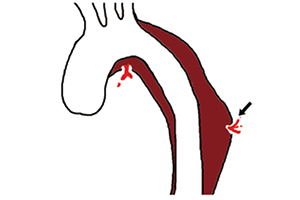Best surgical option for arch extension of type B aortic dissection: the open approach
Abstract
Arch extension of aortic dissection (AD) is reported to occur in 4-25% of patients presenting with acute type B AD. The DeBakey and Stanford classifications do not specifically account for this subset, however, recent studies have demonstrated that the prognosis of patients with arch extension in acute type B AD is virtually identical to that of others with type B AD. In this sense, it seems reasonable to extend the general management principles that are applied to classic acute type B AD even to patients with arch extension. This may be because even in patients with arch extension, most complications occur at locations distal to the arch, and therefore treatment of these patients is similar to that of complicated type B AD, namely thoracic endovascular aortic repair (TEVAR). Conversely, 10% of patients with acute type B AD and arch extension develop complications that are directly related to the arch pathology. This clinical scenario generally necessitates surgical arch repair through a sternotomy approach. The frozen elephant trunk technique combined with arch repair is a very reasonable option to treat this unique clinical entity that involves relatively distal locations of the aortic diseases. Combined arch and descending aorta replacement through thoracotomy is an alternative option particularly when the anatomical features of the target lesions are not suitable for a sternotomy approach or TEVAR. Nonetheless, the reported mortality associated with this approach has been exceedingly high. Hybrid arch repair is another consideration in treating these patients to reduce the treatment-related mortality and morbidity, especially when the arch pathology is limited to the distal part. Nevertheless, the safety and efficacy of this procedure in cases with more extensive arch involvement needs to be assessed in further studies in comparison with other treatment modalities.
Cover






